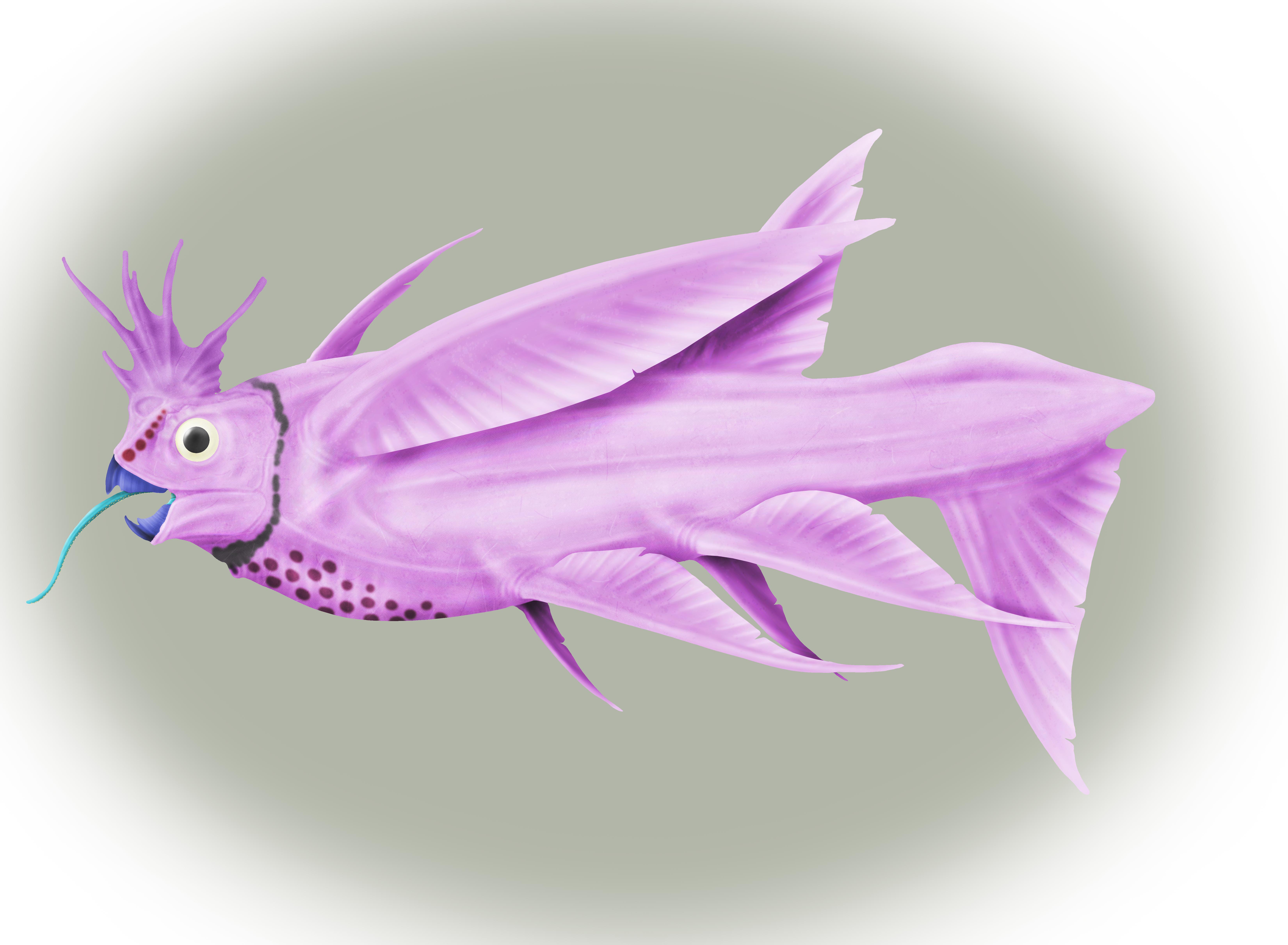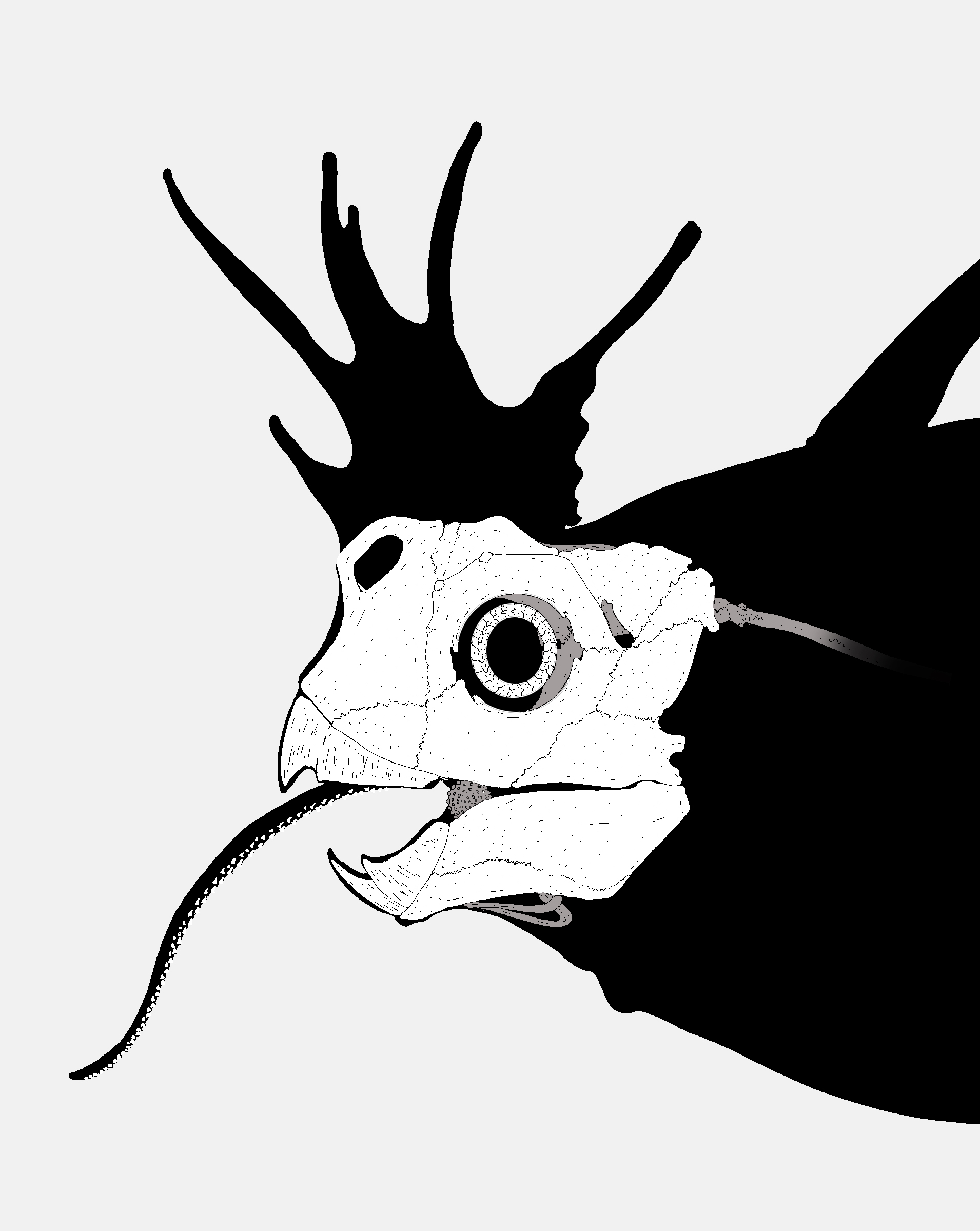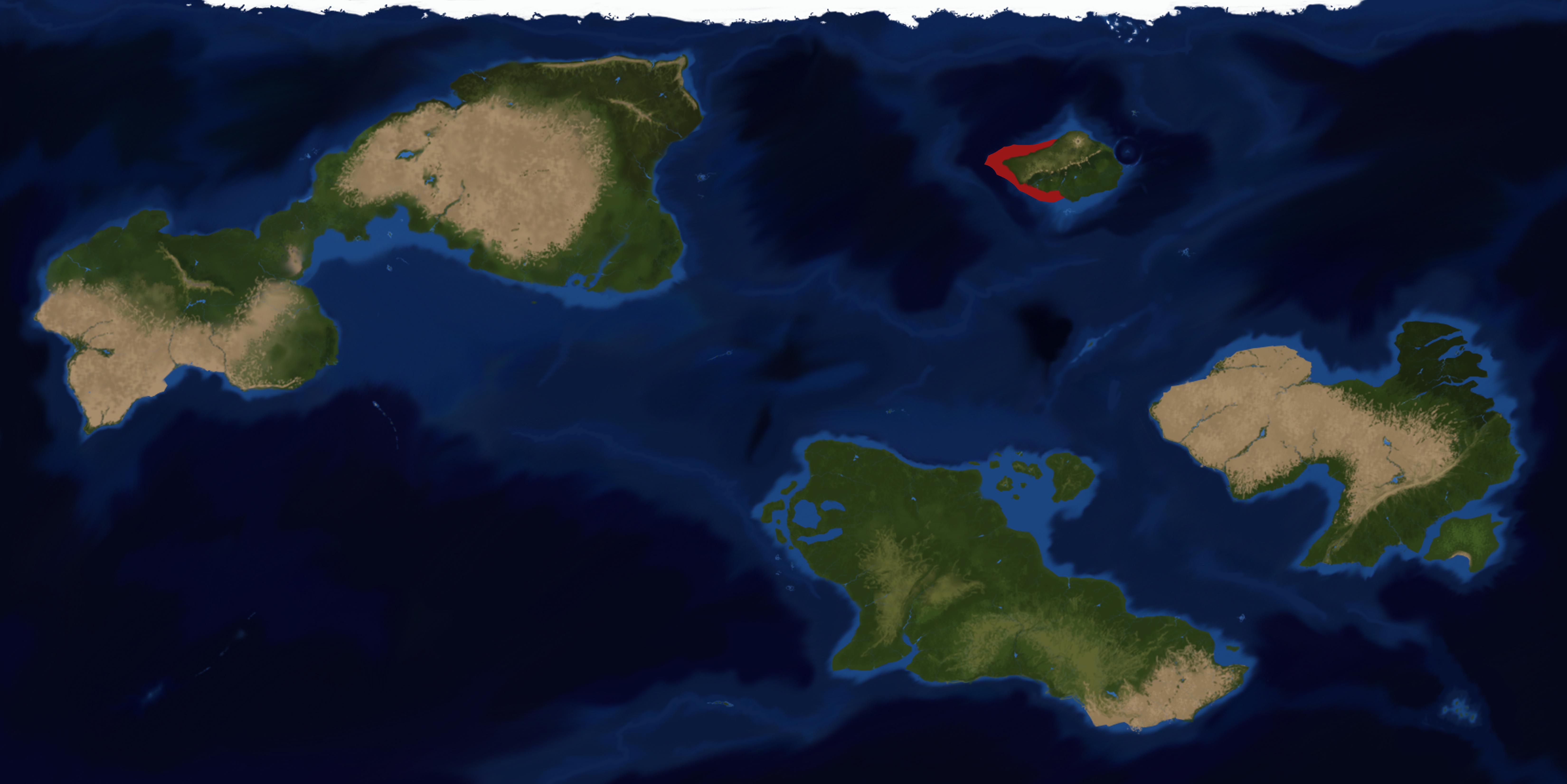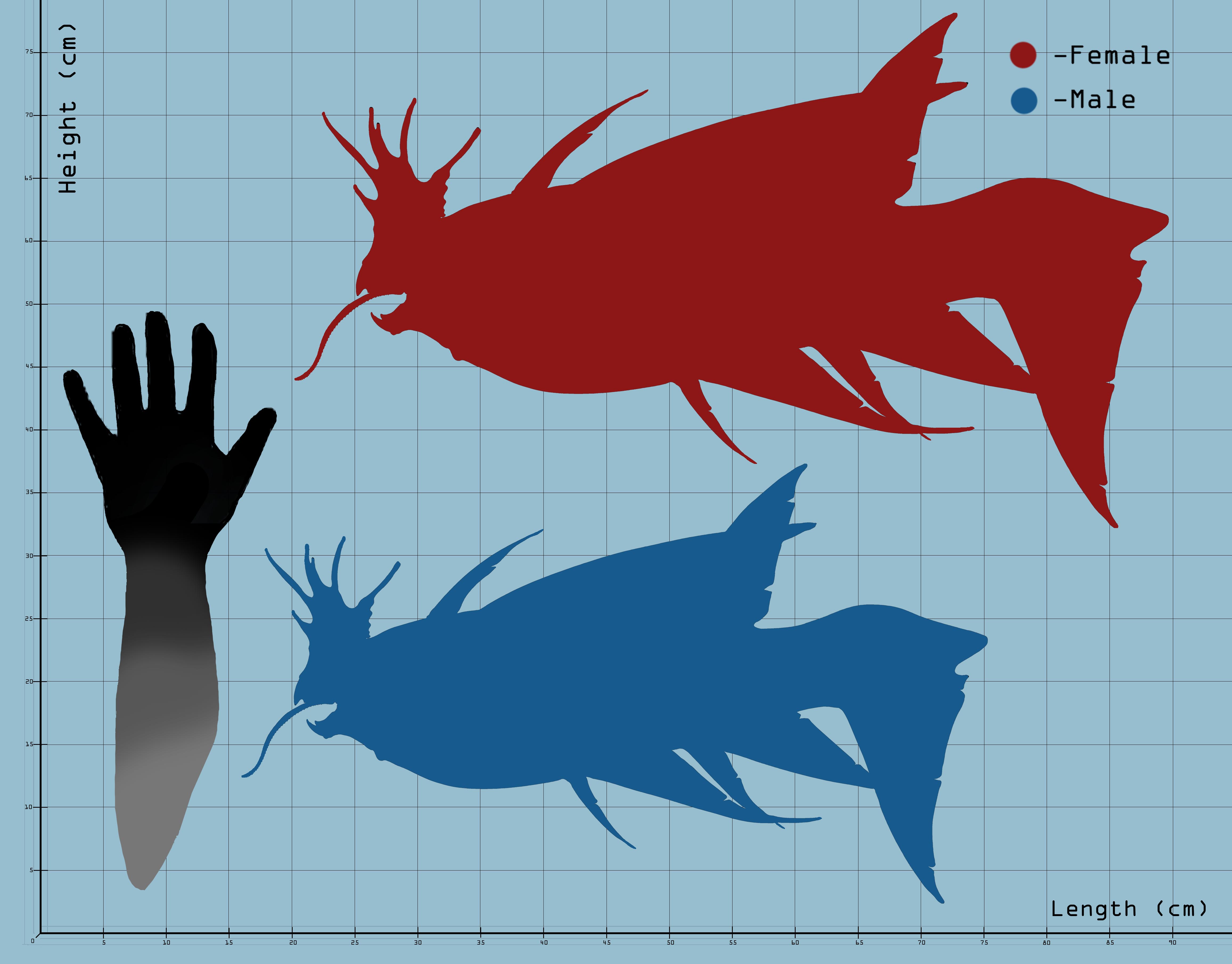Mime Cockatielfish
Psittacosteocristomimus fortirostris is a species of Psittacoraptorine Galeacristatoid amphibian from the Baloon forests of west Gleann Blathànna.
They evolved alongside its main prey item, the Cockatielfish, to mimic it both in shape and colour; through means of aggressive mimicry, the animal lures in its victims.
Opposed to Psittacosteocristi navimorphus, this animal lives most of its life at medium depths, rarely surfacing.
The species can be distinguished from its herbivorous cousin by the slightly different crest, shape, positioning and colour of the beak, the presence of a grey ring around the neck and the differing morphology and posture of the pectoral fins.
This animal's deception, however, is not limited purely to the shape of the body; to better lure in prey, it will also imitate the changes in colours and patterns on the crest that its prey uses to communicate, more specifically using the mating and distress signals.
The long raptorial tongue, covered in small teeth, is used to grapple prey and bring it to the sharp and hooked beak, which will easily lacerate and chop down prey.
Living below the surface level of the balloon sea, it evolved a more slimmed body to accommodate faster speeds and made its cranial skeleton lighter to counterbalance the heavy beak.
Sometimes called by local populations the "Cockatiel trap", the animal is treated like vermin in the few fishing spots of the balloon sea and has been eradicated from several areas to favour local growth of Cockatielfish populations.
Its meat is unappetizing and stringy, a further reason for it to be hunted away from fishing locales.
The more aggressive look and higher physical strength compared to its prey make this a popular game animal among the sportfishing enthusiasts, who will venture deep into the balloon maze to get a chance at fishing animals such as this one and the Arakapiris.
Basic Information
Anatomy
- Head subquadrate, complex crest morphology.
- Beak large and thick, pointed horizontally, jaw quadrate and high.
- Presence of a long prehensile raptorial tongue.
- Pectoral fins Long and spear shaped, slightly upward pointed in rest position.
- Anal I & II speartip shaped, with stubby terminal extensions.
- Dorsal fin triangular.
- Gill Tail short ending in a long and low Gill Fan.
- Lower Caudal fin subtriangular and veiled.
Genetics and Reproduction
Seasonally Monogamous species.
P. fortirostris mates in late spring, in preparation to the Cockatielfish's mating season.
Females will signal the male their receptivity by waving their pectoral fins rapidly, helping the dissemination of the female's pheromones in the water.
During this period the females will change their pigmentation to a brighter one as the neck ring gets more visible.
Males will fight for the female by chasing each other up to the surface, flashing their crests bright colours to intimidate the opponent; the first male to either flee the scene or move to a belly-up position automatically resigns its right to mate with the female.
The winner will have to then subdue to the female, which will try to fight back his advances violently; to subdue the female, the male will use the long raptorial tongue to block her mouth from opening, while the extended parapenis, longer than the male itself, will wrap around the abdominal region of the partner, blocking her movements as only the terminal part of it is used to fertilize her.
As soon as the male is finished mating, it will have to flee the scene as the female will try to chase him down and eat him.
The female lays her eggs on the bottom of the most matured Balloon trees and will abandon the nest shortly after.
The eggs will hatch in the summer when the balloon tree blossoms and subsequently sinks.
The sunken tree's body will be used by the Cockatielfish as a nest and the young of the two species will be born one shortly after the other, giving the baby P. fortirostris a steady food supply for the first few weeks of life in the form of eggs and hatchlings that try to swim to the surface.
Growth Rate & Stages
Ontogenesis very marked in the species.
Hatchlings are born with no cranial crest and a small atrophic upper caudal fin, during this stage it's quite common to confuse the hatchlings of the two species.
Loss of natal aculeus a week after birth.
Young specimens will remain among the Balloon tree cemetery for a few weeks after hatching before moving out in the open waters of the shallow sea; during this period they'll feed on yet unhatched eggs both of Cockatielfish and of their own species.
They'll also hunt down the young prey and smaller conspecifics.
Ecology and Habitats
Epipelagic species found at depths between 15 and 60 m.
Lives in the middle layer of water under the Balloon tree forests, luring in prey out of reach from the predatorial tendrils of the dominant flora.
Dietary Needs and Habits
Predatory species specialized in hunting Cockatielfishes.
It also hunts other small amphibians and cnidarovertebrates like Hijerakids and tartarosomnians.
Biological Cycle
Seasonal species most active from spring to late autumn, when Cockatielfishes are most active.
During the winter they'll infiltrate Cockatielfish shoals inside the Balloon trees, entering stasis alongside them to benefit from the collective warmth and preserve energy.
During this period of stasis, they won't hunt their natural prey, even though they rest right alongside it but will use the occasion to better learn to imitate the visual communication of their game.
Additional Information
Social Structure
Not very social, they'll rarely tolerate conspecifics.
Domestication
Unlike the friendlier cockatielfishes, these animals are much more aggressive even in captivity, making them unsuitable pets.
Nonetheless they are kept in home aquariums by several collectors and professional aquarists.
Uses, Products & Exploitation
Mostly seen as a pest, the species has been hunted extensively both to promote local prey populations used by humans for food and caught for sportfishing.
Even though populations have been steadily declining, no measures have been put in place to protect the species as at the time of writing.
Geographic Origin and Distribution
Perception and Sensory Capabilities
Good Eyesight and hearing.
Symbiotic and Parasitic organisms
Afflicted by Intestinal Tube Worms and parasites of the fins.
In 2461 the species suffered great losses due to a pandemic of Cluster skin disease afflicting local populations.
Scientific Name
Eoichthyia; Caudonatatia; Pedalionmorpha; Galeocristatoidea ; Thoracofluitidae; Psittacoraptorinae; Psittacosteocristomimus; P. fortirostris
Lifespan
12 Years
Conservation Status
Vulnerable: Habitat loss and overhunting threaten the species; no measures underway to protect it
Population Trend: DECLINE
Average Weight
3-9 kg
Body Tint, Colouring and Marking
Pink to light purple body, slightly darker crest.
Blue beak and azure raptorial tongue.
Dark grey neck ring, single row of red spots along the forehead and in the ventral area of the body up to the first Anal fin.
Remove these ads. Join the Worldbuilders Guild













Comments